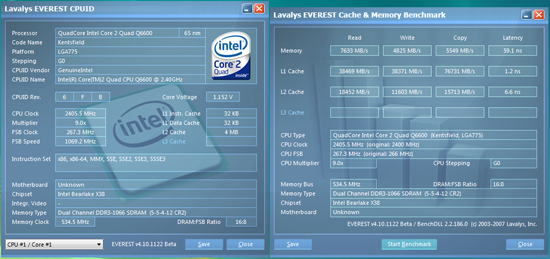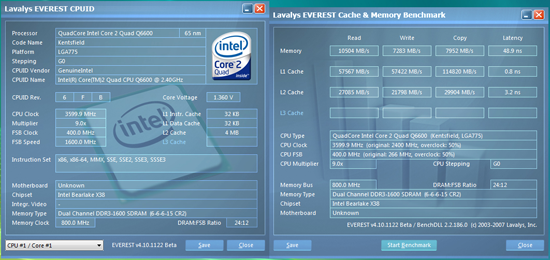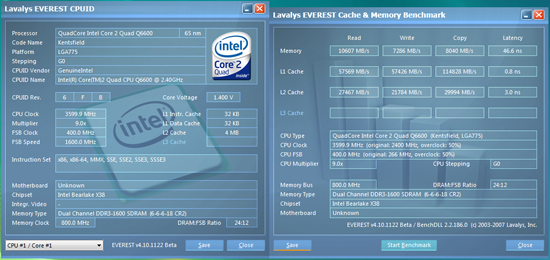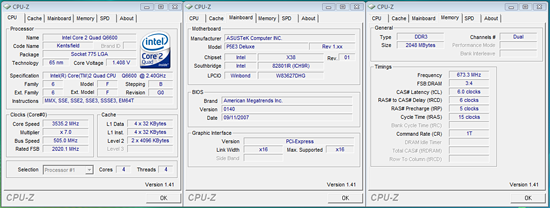ASUS P5E3 Deluxe: X38 and DDR3 arrives... almost
by Gary Key on September 18, 2007 4:00 AM EST- Posted in
- Motherboards
Memory Testing
The Sandra unbuffered scores on the Gigabyte X38 DDR2 board are around 2% better than the ASUS X38 DDR3 board and about 4% better than the abit P35 board. Our Gigabyte board is a production sample board with an early release BIOS. The scores have dropped about 1% from the engineering board we tested previously, although Gigabyte confirms that the BIOS is not fully tuned yet.
We did not expect the memory performance of DDR3 to be this close to the DDR2 board as we noticed significant differences on the P35 boards when running DDR3 at 1066. Intel and the board manufacturers have repeatedly said the X38 chipset will show improved performance with DDR3, especially with the 1333MHz FSB CPUs that allow DDR3 to run at stock 1333MHz rates. The latest BIOS spins show this trend and hopefully the retail releases will show the same progress we have noticed over the past couple of days. However, the price differential between the two memory technologies still means the DDR3 boards will be relegated to the very high end of the market for the near future.
Q6600 9x266
Q6600 9x333
Q6600 9x400
Our memory results are very preliminary considering the beta nature of the latest 1.4 BIOS. We are not showing comparisons to the other DDR3 boards until the BIOS is finalized, but at this time it appears performance is generally a few percent better than the X38 DDR2 boards. In the 9x400 results, the top screenshot is with the system set to the 400 strap and the bottom screenshot is with the 333 strap setting. The improvements in chipset latencies result in slightly better read/write/copy numbers and memory latency is improved about 5%, although tRAS timings were increased from 15 to 18. However, we had to increase our MCH voltage by .04V and CPU voltage from 1.375V to 1.41875V.
Speaking of CPU voltages, we had no issues completing our entire benchmark test suite with our Q6600 set to 1.1500V at stock settings, 1.19375V at 9x333, 1.3750V at 9x400, and 1.44375V at 7x505. Even though we are not at liberty to discuss overclocking results at this time, we do have permission to show our top FSB overclock with the Q6600.
We were able to reach a final FSB setting of 505 with our Q6600. This required the 400 strap setting, MCH voltage to 1.77V, and several other BIOS settings that we will discuss in the launch article. The board actually posted our Q6600 at 522FSB, but benchmark stability was not reached until the 505FSB level. We hit 498FSB with 4GB of memory and the same settings. Hopefully the latest chipset spin and BIOS tweaks will improve upon this result. Vdroop averaged around .02~.04V throughout testing with CPU Voltage Damper enabled; without it, we noticed Vdroop around .07V~.09V when overclocking a quad-core CPU.
 |
| Click to enlarge |
The Sandra unbuffered scores on the Gigabyte X38 DDR2 board are around 2% better than the ASUS X38 DDR3 board and about 4% better than the abit P35 board. Our Gigabyte board is a production sample board with an early release BIOS. The scores have dropped about 1% from the engineering board we tested previously, although Gigabyte confirms that the BIOS is not fully tuned yet.
We did not expect the memory performance of DDR3 to be this close to the DDR2 board as we noticed significant differences on the P35 boards when running DDR3 at 1066. Intel and the board manufacturers have repeatedly said the X38 chipset will show improved performance with DDR3, especially with the 1333MHz FSB CPUs that allow DDR3 to run at stock 1333MHz rates. The latest BIOS spins show this trend and hopefully the retail releases will show the same progress we have noticed over the past couple of days. However, the price differential between the two memory technologies still means the DDR3 boards will be relegated to the very high end of the market for the near future.
Q6600 9x266
 |
| Click to enlarge |
Q6600 9x333
 |
| Click to enlarge |
Q6600 9x400
 |
| Click to enlarge |
 |
| Click to enlarge |
Our memory results are very preliminary considering the beta nature of the latest 1.4 BIOS. We are not showing comparisons to the other DDR3 boards until the BIOS is finalized, but at this time it appears performance is generally a few percent better than the X38 DDR2 boards. In the 9x400 results, the top screenshot is with the system set to the 400 strap and the bottom screenshot is with the 333 strap setting. The improvements in chipset latencies result in slightly better read/write/copy numbers and memory latency is improved about 5%, although tRAS timings were increased from 15 to 18. However, we had to increase our MCH voltage by .04V and CPU voltage from 1.375V to 1.41875V.
Speaking of CPU voltages, we had no issues completing our entire benchmark test suite with our Q6600 set to 1.1500V at stock settings, 1.19375V at 9x333, 1.3750V at 9x400, and 1.44375V at 7x505. Even though we are not at liberty to discuss overclocking results at this time, we do have permission to show our top FSB overclock with the Q6600.
 |
| Click to enlarge |
We were able to reach a final FSB setting of 505 with our Q6600. This required the 400 strap setting, MCH voltage to 1.77V, and several other BIOS settings that we will discuss in the launch article. The board actually posted our Q6600 at 522FSB, but benchmark stability was not reached until the 505FSB level. We hit 498FSB with 4GB of memory and the same settings. Hopefully the latest chipset spin and BIOS tweaks will improve upon this result. Vdroop averaged around .02~.04V throughout testing with CPU Voltage Damper enabled; without it, we noticed Vdroop around .07V~.09V when overclocking a quad-core CPU.










60 Comments
View All Comments
Gary Key - Wednesday, September 19, 2007 - link
We do not disable services as we try our best to mimic the user experience. Obviously, clearing the Prefetch folder does not allow that to happen but it is the only way to get consistent results. Over time we have seen the benchmark scores move up to 3% when leaving Prefetch enabled, does not sound like that much, but we try our best to keep the benchmark variables under 0.5% within the test suite. Also, Vista has just about doubled the time it takes to run the benchmark test suite, if you ever had an issue sleeping, just watch WorldBench 6.0 run five times in a row.FireTech - Tuesday, September 18, 2007 - link
Gary where are the promised µATX and P35 round-ups?After 6+months, you've run out of credit at the excuses bank. It's time to deliver on your promises, then you can get back to the Intel launch parties....
Gary Key - Tuesday, September 18, 2007 - link
µATX G33 will be next Wednesday and will include the NV MCP73, the first P35 series will start this Friday with the Foxconn MARS board and the abit/Gigabyte mid-range boards late next week. The AMD µATX is scheduled on 10/2 with the budget P35 boards following on 10/5.FireTech - Wednesday, September 19, 2007 - link
Sorry Gary but these similar words are still fresh in my memory:Are these new dates set in stone?
Gary Key - Wednesday, September 19, 2007 - link
Still fresh in my memory also. ;-) Yes, the dates are set, the only one that might move a day or so is the second P35 article for late next week. AMD is going to have a Phenom/RD790 preview that I might have to attend next Thursday. Otherwise, the dates are good this time. Email me and I will explain the situation.JKing76 - Tuesday, September 18, 2007 - link
New chipset, great. Are we ever going to see the fucking micro-ATX roundup? And no, I don't count that bullshit "dedicated video is faster than integrated video" part 1 fluff.Nickel020 - Tuesday, September 18, 2007 - link
Hey, thanks for throwinf us a bone Gary! ;)I was wondering what the max FSB of the exact CPU used in the tests was when using P35 boards? Thats one of the biggest hopes that people have for teh X38, that it will allow higher FSBs for quads, because as of now, most people can't get over around 450 FSB on a P35 when using a quad.
Gary Key - Tuesday, September 18, 2007 - link
The max (stable) FSB of the Q6600 on the Blitz Extreme was 468, on the DFI P35-T2R (is an absolute knock out with the 9/13 beta bios) was 470, P5K Deluxe is 464, and abit IP35-Pro was 462. The X38, once mature, will really improve overclocking of the current processor lineup (until you hit the CPU FSB wall) but is really designed to shine with Penryn.However, I believe Intel has just about reached the limits of what they can do with the memory controller based on what we are seeing now, so stock performance is not going to vary that much from a P35 or even 680i/975x in most situations. It appears the BIOS spins are going to need a month or two to really extract the best performance out of the chipset, and DDR2 performance is not that impressive at this time. We will show numbers with DDR2-800 at 3-4-3-9 as a base and a really good P35 board is going to give some of these X38 boards a run for their money until you get the DDR2 speeds up around 1100.
My personal opinion is that the DDR2 X38 boards will quickly replace the upper end P35 boards in the market since the price points will be the same after the launch hysteria is over. Expect to see the P35 drop to the $75~$150 market only by early next year.
Nickel020 - Wednesday, September 19, 2007 - link
Thanks a lot for the reply Gary!You got me thinking again though, I was just going to sell my P35 DS3 and keep the P35 DQ6 for Penryn. But maybe I should sell the DQ6 now as long as it's worth something and use the DS3 until X38 Boards are somewhat mature and then upgrade (and sell the DS3).
Do you think X38 DDR2 Boards will have a significant overclocking & performance advantage over P35 boards with Penryn?
Gary Key - Thursday, September 20, 2007 - link
They are showing around a 5%~9% improvement currently, but I have not received a P35 optimized BIOS for Penryn yet, but then again, the X38 BIOS releases are still immature. We will know more in a couple of weeks I think but right now, unless you go DDR3, not seeing any real performance improvements with DDR2 on the retail X38 boards, a couple of percent here and there but the DFI P35-TR2 board is faster than the X38 DDR2 boards I have right now for single card GPU situations. Still waiting on another BIOS release or two before publishing the final numbers. ;-)